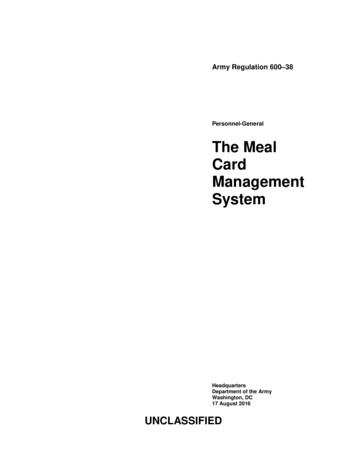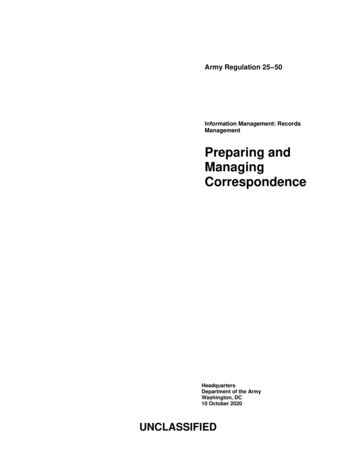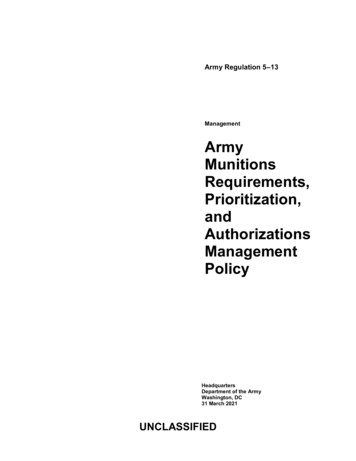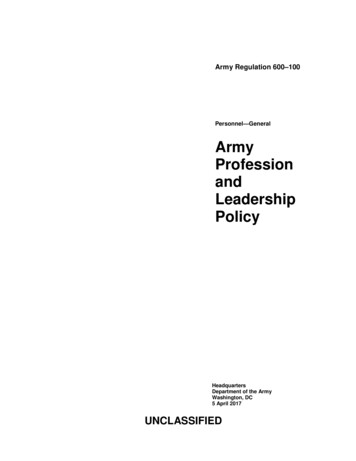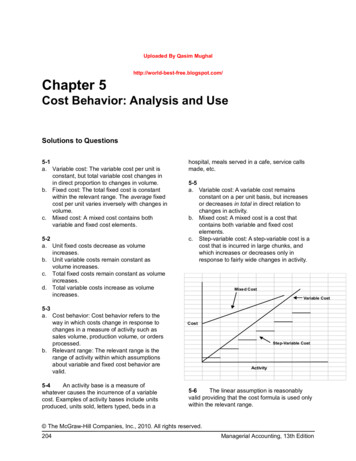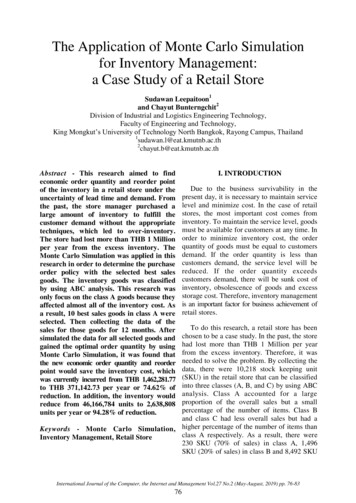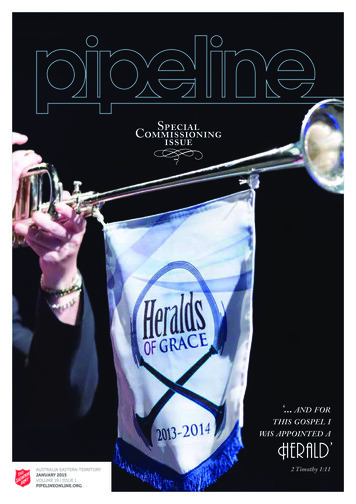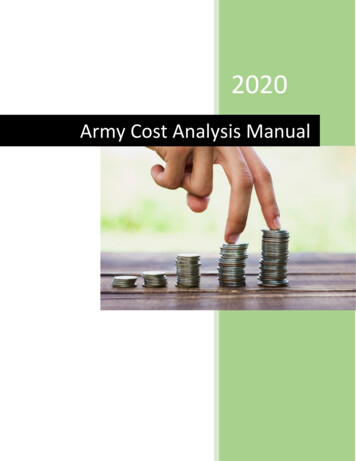
Transcription
2020Army Cost Analysis Manual
ARMY COST ANALYSIS MANUALFOREWORDThe mission of the Office of the Deputy Assistant Secretary of the Army - Cost and Economics(ODASA-CE) is to provide Army decision-makers with cost, performance, and economic analysis.ODASA-CE is the principal advisor to the Assistant Secretary of the Army (Financial Management andComptroller) (ASA (FM&C)) for all Army cost and economic analysis activities. Recognizing the needfor timely Army reference material, ODASA-CE produced this manual to provide a solid foundation incost analysis for Army analysts. The manual is intended to provide junior analysts with material that canbe easily understood and applied, while serving as a reference for senior analysts.This manual supersedes the May 2002 Department of the Army Cost Analysis Manual.1-1
ARMY COST ANALYSIS MANUALTable of ContentsChapter 1 Introduction . 1-71.Purpose of the Army Cost Analysis Manual (CAM) . 1-72.Overview of Cost Analysis . 1-7Chapter 2 Cost Analysis References . 2-81.Introduction . 2-82.Key Documents . 2-8Chapter 3 Cost Estimating Process . 3-81.Introduction . 3-82.Planning. 3-9i.Define the Estimate’s Purpose . 3-9ii.Define the Estimating Team . 3-11iii.Define the Estimating Schedule . 3-113.Data Collection. 3-12i.Define the Program . 3-12ii.Determine the Cost Structure . 3-13iii.Obtain the Data . 3-144.Develop the Point Estimate . 3-175.Conduct Sensitivity Analysis . 3-176.Risk and Uncertainty Analysis . 3-187.Presentation . 3-188.Updating . 3-189.Documentation . 3-1810.Rough Order of Magnitude (ROM) Estimates . 3-19Chapter 4 Cost Estimating Methodologies . 4-201.Extrapolation from Actuals . 4-202.Parametric Cost Estimating . 4-203.Analogy . 4-204.Engineering (Bottoms Up) . 4-215.Expert Opinion . 4-21Chapter 5 Inflation . 5-21Chapter 6 Acquisition Costing . 6-251.Introduction . 6-252.Milestones . 6-25i.Milestone A . 6-251-2
ARMY COST ANALYSIS MANUALii.Development Request for Proposal Release Decision Point . 6-25iii.Milestone B. 6-25iv.Low Rate Initial Production (LRIP) and Milestone C . 6-26v.Full-Rate Production (FRP) . 6-26vi.Post-Initial Operational Capability (IOC) . 6-263.Appropriations . 6-26i.RDT&E . 6-26ii.Procurement . 6-26iii.Military Construction (MILCON) . 6-27iv.Military Personnel (MP) . 6-27v.O&M . 6-274.Unit Costs . 6-27i.Average Procurement Unit Cost (APUC) . 6-28ii.Program Acquisition Unit Cost (PAUC) . 6-28iii.Average Manufacturing Unit Cost (AMUC) . 6-28Chapter 7 Software Cost Estimating . 7-281.Introduction . 7-282.Software Development . 7-28i.Sizing Metrics . 7-28ii.Productivity . 7-293.Software Maintenance . 7-30i.4.Software Maintenance WBS . 7-30Off-the-shelf (OTS) . 7-30Chapter 8 Military Construction Costing. 8-311.Introduction . 8-312.Sustainment Restoration and Modernization (SRM) Cost Components. 8-323.Base Operations Support/Maintenance (BOS) Cost Components . 8-324.Guidance/Source References for Generating MILCON, SRM, and Maintenance Estimates . 8-33Chapter 9 Demilitarization and Disposal (D&D) Costing . 9-331.Background . 9-332.Resources . 9-333.Methodology . 9-344.Example of EQLCCE or D&D Cost Analysis Using MS Excel . 9-35Chapter 10 Force Costing . 10-381-3
ARMY COST ANALYSIS MANUAL1.Introduction to Force Costing . 10-382.Activation . 10-383.Inactivation . 10-394.Acquisition of Resources . 10-395.Operations & Sustainment (O&S). 10-396.Movement of Units. 10-407.Contingency Operations/Exercises . 10-408.Force Design Update (FDU)/Concept Plan . 10-409.Stationing/Location . 10-4110.Site. 10-4111.FCM . 10-41i.Costing . 10-41ii.Life Cycle Events . 10-41iii.Acquisition of Resources . 10-4212.ACM . 10-4313.TDA. 10-4414.CFH . 10-44Chapter 11 Acquisition Life Cycle Costing Considerations . 11-441.Different Types of Cost Estimates . 11-44i.POE. 11-45ii.CCE . 11-45iii.ICE . 11-45iv.ACP . 11-452.Cost Review Board. 11-463.Selected Acquisition Report (SAR) . 11-484.i.Acquisition Program Baseline (APB) vs SAR: . 11-49ii.Variance Analysis . 11-49iii.Nunn-McCurdy Breaches . 11-49iv.Other Breaches . 11-50Life Cycle Management Command (LCMC) . 11-50Chapter 12 DASA-CE Cost Tools . 12-501.AMCOS. 12-502.Army Civilian Pay Rates . 12-523.Reimbursable Rates . 12-521-4
ARMY COST ANALYSIS MANUALi.Aviation Reimbursable Rates: . 12-52ii.Ground Reimbursable Rates: . 12-534.ACEIT . 12-535.JIAT. 12-536.GFEBS . 12-557.GCSS-Army . 12-568.FORCES . 12-56i.Unit Structure . 12-57ii.FCM . 12-59iii.ACM . 12-59iv.TDA . 12-60v.CFH . 12-609.Fully Burdened Cost of Energy-Fuel . 12-6010.OSMIS . 12-62i.Overview of O&S . 12-62ii.Introduction to OSMIS Database . 12-63iii.Cost Element Structure (CES) . 12-65Chapter 13 C-BAs and Guidance . 13-721.Introduction . 13-722.What is a Cost-Benefit Analysis?. 13-723.When Should a Cost-Benefit Analysis Be Performed . 13-73Appendix 1: Acronyms . 2Appendix 2: Definitions. 10Appendix 3: Key Unit Cost Definitions. 121.Hardware Unit Cost . 122.Rollaway Cost . 123.Weapon System Cost . 124.APUC: Also known as Procurement Unit Cost . 135.PAUC . 136.Life Cycle . 13Appendix 4: Army Cost Estimating Structure (ACES) . 141.ACES for DBS . 142.ACES for Non-DBS . 36Appendix 5 Prior ACES to CAPE O&M Crosswalk . 731-5
ARMY COST ANALYSIS MANUALAppendix 6: Figures . 80Appendix 7: Example Documentation . 81Appendix 8: Economic Useful Life (EUL) Commodity Matrix-Guide to EUL Values for Cost Estimating. 82Appendix 9: Lessons Learned/White Papers . 851-6
ARMY COST ANALYSIS MANUALChapter 1 Introduction1.Purpose of the Army Cost Analysis Manual (CAM)The purpose of the Army Cost Analysis Manual (CAM) is to provide procedures for implementing Armycost analysis policies. The CAM provides specific emphasis on the cost estimation portion of costanalysis, providing a framework for the development, documentation, and use of cost estimates.Additionally, the CAM provides details on the analysis of the data that feeds the cost estimate. The CAMcontains useful information for analysts involved in every stage of the cost analysis process, includingthose who provide input for cost analysis, those who produce cost analysis products, and those who use theresults of cost analysis. The CAM is not intended to supplant the need for formal cost analysis training.2.Overview of Cost AnalysisThe Government Accountability Office (GAO) defines cost analysis as: the effort to develop, analyze, and document cost estimates with analytical approaches andtechniques;the process of analyzing, interpreting, and estimating the incremental and total resources requiredto support past, present, and future systems—an integral step in selecting alternatives; anda tool for evaluating resource requirements at key milestones and decision points in the acquisitionprocess. 1Cost analysis is used to produce cost estimates for materiel systems, automated information systems, forceunits, training, and other Army programs and projects. Cost analysis enables the Army to make costinformed decisions. Cost analysis also supports management decisions by quantifying the resource impactof alternative options. Cost analysis plays a key role in budgeting the Army's operations tempo(OPTEMPO) related costs, as well as the management of base operations. Cost analysis provides Armyplanners with reliable information about the cost consequences of program changes, extensions, orcancellations.Cost analysis is not without its limitations; estimates are developed with imperfect understanding of thetechnical merits and limitations of the item, historic data is always subject to interpretation, and there arealways future uncertainties. However, despite the limitations, cost analysis is a powerful tool. The processof cost analysis is the most rigorous approach available to evaluate the costs of alternatives for the decisionmaker.Cost estimating is a specific activity within cost analysis. 2 Cost estimating is the process by which afuture cost is predicted based on adjusted historical costs. The topic of cost estimating is explored in laterchapters with Chapter 3 covering the cost estimating process and Chapter 4 covering cost estimatingmethodologies.1GAO-09-3SP GAO Cost Estimating and Assessment Guide: Best Practices for Developing and Managing Capital ProgramCosts pg. 31.2GAO-09-3SP GAO Cost Estimating and Assessment Guide: Best Practices for Developing and Managing Capital ProgramCosts pg. 31.1-7
ARMY COST ANALYSIS MANUALChapter 2 Cost Analysis References1.IntroductionCost analysis is an integral part of the defense acquisition process. Effective cost estimating requiresengagement and awareness of how all technical, functional disciplines influence a system’s life cycle cost.This chapter provides a number of required and related materials for effective Army cost analysis.2.Key DocumentsKey documents impacting Army cost analysis include the following:1. Planning, Programming, Budgeting, and Execution, AR 1-1, which establishes the requirements forASA(FM&C) and the responsibility utilizing cost in the PPBE process.2. Cost and Economics Program, AR 11-18, which specifies the policies and responsibilities for costand economic analysis throughout the Army.3. The Department of Defense Instruction (DoDI) 5000.02, 24 October 2019, “Operation of DefenseAcquisition System,” which establishes the policy for managing of acquisition programs, includingcost reporting requirements and thresholds as well as Acquisition Category (ACAT) designationsand descriptions.4. DODI 5000.73, “Cost Analysis Guidance and Procedures” which provides procedures for theconduct of cost estimation and analysis within DoD.5. The 2016 National Defense Authorization Act (NDAA), section 804, which establishes middle-tieracquisition for rapid prototyping and rapid fielding.6. DODI 5000.75, “Business Systems Requirements and Acquisitions,” which establishes policies forDBS.7. DODI 5000.74, “Defense Acquisition of Services,” which provides policies for the acquisition ofservices.8. DODI 7041.03, “Economic Analysis for Decision Making,” which provides policies for economicanalysis.9. DoD Cost Assessment & Program Evaluation (CAPE) memos located athttps://cade.osd.mil/policy/nonacat1, which provide policies for Non-ACAT I programs.10. MIL-STD-881D, which provides Work Breakdown Structures for commodities.11. GAO Cost Estimating and Assessment Guide: Best Practices for Developing and ManagingCapital Program Costs, GAO-09-3SP, which provides best practices for cost estimating.12. Joint Agency Cost Schedule Risk and Uncertainty Handbook, which provides policies for thetreatment of risk and uncertainty.Chapter 3 Cost Estimating Process1.IntroductionAs briefly explained in Chapter 1, cost estimating is the process by which historical costs are used to predictfuture costs. During the cost estimating process, analysts estimate the value of individual elements usingestablished methodologies to project future costs from historical values. Cost estimation enables systemand functional requirements to be translated to budget requirements. Cost estimating provides aquantitative basis for management decisions regarding optimal allocation of resources.The following diagram, Figure 1, provides a view of the Cost Estimating Process:3-8
ARMY COST ANALYSIS MANUALFigure 1: The Cost Estimating ProcessAs Figure 1 demonstrates, documentation is important during every stage of the process.2.Planningi.Define the Estimate’s PurposeThe first step in the cost estimating process is to define the purpose of the estimate. An estimate’s purposedictates the estimate’s scope, time requirements, level of detail, estimate techniques, and type ofdocumentation required. There are two general reasons for an Army analyst to engage in cost estimation:1. Budget Formulation2. Comparative Studies.Chapter 13 provides additional information on a specific type of comparative study, known as a costbenefit analysis (C-BA).1.Budget FormulationBudget formulation estimates can support a number of activities, including acquisition, base supportoperations, installation management, and personnel requirements. The types of activities will vary basedon a variety of factors including the system acquisition category (ACAT) and stage of the system’s lifecycle. The types of estimates associated with budget formulation include: Program Office Estimate (POE): The program office develops the POE to support specificacquisition milestone requirements. The POE should reflect the program described in the CostAnalysis Requirements Description (CARD), or other system definition documents, if a CARDis not available.Component Cost Analyses (CCA): An agency not in the acquisition community develops theCCA to support specific regulatory acquisition milestone requirements. Analysts use the CCAto test the reasonableness of the POE.Component Cost Estimate (CCE): DoDI 5000.02 requires the DoD Component to develop anestimate that covers the entire life cycle of the program for all MDAPs prior to Milestone A, B,3-9
ARMY COST ANALYSIS MANUAL and C reviews and the Full-Rate Production Decision and for all Major Automated InformationSystems (MAIS) programs at any time an Economic Analysis is due. 3Component Cost Position (CCP): DoDI 5000.02 requires the DoD Component and the ServiceCost Agency to establish a documented CCP that covers the entire life cycle of the program forall MDAPs and MAIS programs prior to the Milestone A, B, and C reviews, and the FRP (FullRate Production) Decision or Full Deployment Decision Review. The DoD Component CostPosition must be signed by the appropriate DoD Component Deputy Assistant Secretary forCost and Economics (or defense agency equivalent) and must include a date of record. 4Additionally, the DoD Component must fully fund the program to the CCP in the current FutureYears Defense Program (FYDP) or commit to full funding within the next FYDP whileidentifying offsets to address shortfalls within the current FYDP. The CCP for the Army isknown as the Army Cost Position (ACP).Independent Cost Estimate (ICE): The ICE is required by 10 USC 2434. The Office of theSecretary of Defense Cost Assessment and Program Evaluation (OSD CAPE) conducts orapproves ICEs at the following points:o (a) In advance of any Milestone A certification under section 2366a of Title 10, U.S.C., orMilestone B certification under section 2366b of Title 10, U.S.C.o (b) In advance of any decision to enter low-rate initial production (LRIP) or full-rateproduction (FRP).o (c) In advance of any certification for critical Nunn-McCurdy breaches under section 2433aof Title 10, U.S.C.o (d) At any other time considered appropriate by the Director of Cost Assess
Mar 30, 2020 · 11. GAO Cost Estimating and Assessment Guide: Best Practices for Developing and Managing Capital Program Costs, GAO-09-3SP, which provides best practices for cost estimating. 12. Joint Agency Cost Schedule Risk and Uncertainty Handbook, which provides policies for the treatment of risk and uncertainty.



